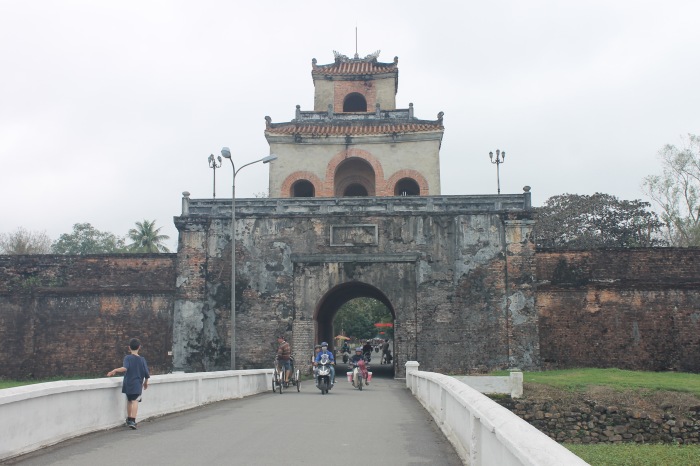Hue was the capital of Vietnam for most of the 19th century, the reign of the Nguyen dynasty. They built the citadel, a walled city on the banks of the Perfume River, and buried their emperors in marvelous tombs upstream. Though they continued to live in Hue, the Nguyens lost real power in 1885 when the French raided the citadel and took or burned everything of value.
Hue next came to fame during what they call in Vietnam the “American war,” when the Vietnam Cong seized the citadel during the Tet Offensive. When the US retook Hue, they destroyed much of the citadel in the process. Today, the citadel is a large walled and moated city, a square 1-2 miles on a side. The royalty lived in a smaller “citadel inside a citadel” called the Imperial Enclosure.
Today, we woke to gray, rainy weather. We went out for breakfast, but came back for some school work. By 11, the rain had stopped so we decided to go visit the Imperial Enclosure. We got a small lunch on the way there at a tiny restaurant with a deaf-mute manager. The chicken noodle soup was pretty good.
After entering the outer citadel through an impressive gate,
 we walked by a small museum of military hardware kindly donated by or taken from the US government.
we walked by a small museum of military hardware kindly donated by or taken from the US government.
 We then entered the walled Imperial Enclosure
We then entered the walled Imperial Enclosure
through the Ngo Mon Gate, facing the Thai Hoa Palace.
 The Enclosure had many beautiful, traditional Vietnamese pavilions, some in great shape
The Enclosure had many beautiful, traditional Vietnamese pavilions, some in great shape
 We spent a little time relaxing at the delightful Co Ha Garden,
We spent a little time relaxing at the delightful Co Ha Garden,
 with its many bonsai and other cultivated trees.
with its many bonsai and other cultivated trees.
 By the time we got to the Thai To Mieu Temple Complex, the kids were played out, even though it was one of the best preserved and reconstructed places we saw.
By the time we got to the Thai To Mieu Temple Complex, the kids were played out, even though it was one of the best preserved and reconstructed places we saw.
 It was time for us to start the long walk back to the hostel. In all, we spent about 4 hours walking to, around and back from the citadel, and the kids did great. Tomorrow, we hope to visit some of the tombs up the Perfume River.
It was time for us to start the long walk back to the hostel. In all, we spent about 4 hours walking to, around and back from the citadel, and the kids did great. Tomorrow, we hope to visit some of the tombs up the Perfume River.


